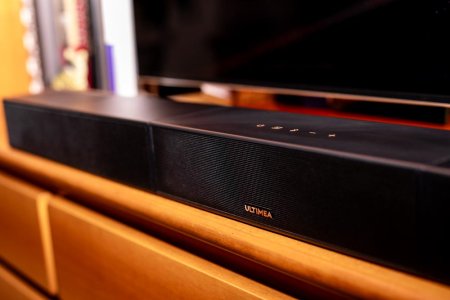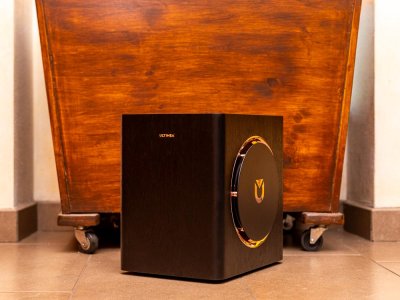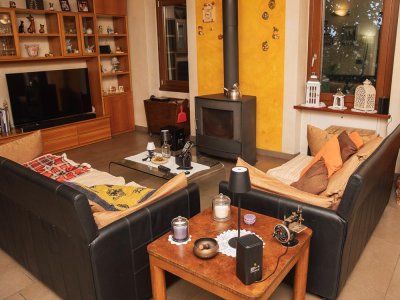Fabio Ronchi
New member
Hi everyone. I wanted to share my impressions of the Ultimea Skywave X40, as there's a lot of hype but also a lot of skepticism.
If you're looking for a real Atmos and surround experience without spending €1000 or destroying your living room, this is one of the best options on the market. It's a clear step up in quality from the brand's past glories (like my old Poseidon D80) and, as we'll see, the quality isn't just marketing but is based on specific technological choices.

First surprise: the unboxing experience is premium. The box is meticulously designed, and all the accessories (including wall mounts and a braided 4K HDMI cable!) are enclosed in a small case with a magnetic closure. The design is minimal but aggressive, with gold details and a wood-like texture on the sub.
Installation is easy. The bar has eARC and, crucially, an HDMI-IN for 4K HDR/Dolby Vision signal pass-through. Perfect for connecting a console (like a PS5 or Xbox) and not losing video quality.
The sub and the two rear satellites are "wireless" and communicate with the bar via a dedicated 5GHz connection, which ensures very low latency (<20ms), essential for gaming. Obviously, each of the four pieces needs its own power outlet.
The app is simple and offers all the remote's functions, but additionally features an Advanced Equalizer—a rare find in this price range—in addition to the usual presets.
It offers three levels of customization:
Yes. And the answer lies in why it works. The immersion of this 5.1.2 system isn't random; it's justified by the right mix of quality hardware and mature technology, which I'll explain in 3 points:
1: Verticality (The Up-Firing Channels and the "NeuraCore" DSP)The "bubble" effect is real because this is a true 5.1.2 setup, with two physical drivers firing at the ceiling. It's not virtual Atmos. The audio reflects off the ceiling and creates that verticality (helicopters, rain) that a 5.1 system was missing.

Orchestrating everything is the "brain" of the system, the NeuraCore DSP. It's a proprietary triple-core processor that decodes native Dolby Atmos and maps every sound "object" to its correct place in 3D space. It also manages an effective Upmix to "spread" Stereo or 5.1 tracks across all channels (although for "pure" music, I recommend disabling it).
2: Clean Power (The GaN Amplifiers)The amplification is GaN (Gallium Nitride). This is a premium technology (usually seen in high-end audio systems) that is much more efficient than silicon. It runs cooler and delivers power (530W peak) more stably and with less distortion. This allows the system to handle sudden peaks without "sagging."

3: Tight Bass (The "Gravus" Side-Firing Sub)Finally, the bass. Unlike many down-firing models (which fire at the floor, smearing the sound), this one has a 6.5" side-firing driver. This design choice, combined with the DSP technology dubbed "Gravus" (which linearizes the response), makes a huge difference in clarity. The result is a tight, precise bass that spreads better in the room, instead of just rumbling "muddily" on the floor.

I put the Skywave X40 to the test with the "Darkstar" scene from Top Gun: Maverick. It's a brutal test: it goes from micro-details in the cockpit, to silence, to the roar of the scramjet.
I placed my Godox IVM-S2 microphone (gain 0dB, no filters) near my usual listening spot to simulate the experience.You can hear the test here: [
]
This brings me to my personal setup. My room is 38sqm (approx. 410 sq ft), which is objectively large for a single 6.5" sub. As expected, I had to push the bass EQ to +5 in the app (I placed it 30cm from the wall, with the speaker facing the center of the room). The bass remains tight and precise.Regarding the satellites. Since I have them close to me (almost to my sides due to lack of space), I had to set their volume to -1 to balance the sound.

Who is it for:
If you're looking for a real Atmos and surround experience without spending €1000 or destroying your living room, this is one of the best options on the market. It's a clear step up in quality from the brand's past glories (like my old Poseidon D80) and, as we'll see, the quality isn't just marketing but is based on specific technological choices.

 1. Unboxing and Setup: The Ecosystem
1. Unboxing and Setup: The Ecosystem
First surprise: the unboxing experience is premium. The box is meticulously designed, and all the accessories (including wall mounts and a braided 4K HDMI cable!) are enclosed in a small case with a magnetic closure. The design is minimal but aggressive, with gold details and a wood-like texture on the sub.Installation is easy. The bar has eARC and, crucially, an HDMI-IN for 4K HDR/Dolby Vision signal pass-through. Perfect for connecting a console (like a PS5 or Xbox) and not losing video quality.
The sub and the two rear satellites are "wireless" and communicate with the bar via a dedicated 5GHz connection, which ensures very low latency (<20ms), essential for gaming. Obviously, each of the four pieces needs its own power outlet.
The app is simple and offers all the remote's functions, but additionally features an Advanced Equalizer—a rare find in this price range—in addition to the usual presets.
It offers three levels of customization:
- Standard Presets: Cinema, Music, Standard, Dialogue, Gaming, and Night (ideal for not disturbing others, as it compresses the dynamics).
- Tone Presets (Pop, Rock, Bass, Classical): An effective middle ground.
- Advanced Equalizer: A complete graphic EQ to adjust individual frequencies.
 2. The Listening Test: Does This Atmos "Bubble" Exist?
2. The Listening Test: Does This Atmos "Bubble" Exist?
Yes. And the answer lies in why it works. The immersion of this 5.1.2 system isn't random; it's justified by the right mix of quality hardware and mature technology, which I'll explain in 3 points:1: Verticality (The Up-Firing Channels and the "NeuraCore" DSP)The "bubble" effect is real because this is a true 5.1.2 setup, with two physical drivers firing at the ceiling. It's not virtual Atmos. The audio reflects off the ceiling and creates that verticality (helicopters, rain) that a 5.1 system was missing.

Orchestrating everything is the "brain" of the system, the NeuraCore DSP. It's a proprietary triple-core processor that decodes native Dolby Atmos and maps every sound "object" to its correct place in 3D space. It also manages an effective Upmix to "spread" Stereo or 5.1 tracks across all channels (although for "pure" music, I recommend disabling it).
2: Clean Power (The GaN Amplifiers)The amplification is GaN (Gallium Nitride). This is a premium technology (usually seen in high-end audio systems) that is much more efficient than silicon. It runs cooler and delivers power (530W peak) more stably and with less distortion. This allows the system to handle sudden peaks without "sagging."

3: Tight Bass (The "Gravus" Side-Firing Sub)Finally, the bass. Unlike many down-firing models (which fire at the floor, smearing the sound), this one has a 6.5" side-firing driver. This design choice, combined with the DSP technology dubbed "Gravus" (which linearizes the response), makes a huge difference in clarity. The result is a tight, precise bass that spreads better in the room, instead of just rumbling "muddily" on the floor.

 3. The Field Test: Top Gun and The Case Study (My 38sqm Room)
3. The Field Test: Top Gun and The Case Study (My 38sqm Room)
I put the Skywave X40 to the test with the "Darkstar" scene from Top Gun: Maverick. It's a brutal test: it goes from micro-details in the cockpit, to silence, to the roar of the scramjet.I placed my Godox IVM-S2 microphone (gain 0dB, no filters) near my usual listening spot to simulate the experience.You can hear the test here: [
This brings me to my personal setup. My room is 38sqm (approx. 410 sq ft), which is objectively large for a single 6.5" sub. As expected, I had to push the bass EQ to +5 in the app (I placed it 30cm from the wall, with the speaker facing the center of the room). The bass remains tight and precise.Regarding the satellites. Since I have them close to me (almost to my sides due to lack of space), I had to set their volume to -1 to balance the sound.

 4. Verdict: Who Is It For? (And Who Is It NOT For?)
4. Verdict: Who Is It For? (And Who Is It NOT For?)
Who is it for:- Anyone who wants a real, immersive Dolby Atmos 5.1.2 experience at a fantastic price.
- Those with small to medium-sized living rooms will feel the bass in their gut! (I'd recommend max 30/35sqm).
- It's a killer gaming package. The combo here is perfect: <20ms latency (thanks to 5GHz), HDMI-IN pass-through (for 4K HDR/Dolby Vision), and Game Mode.
- Those with huge rooms (the X60 or X70 models are better).
- Blu-ray collectors. The lack of DTS support is the product's real Achilles' heel.
- Purist audiophiles who need a €3000 separate component system. (But of course, right?)
